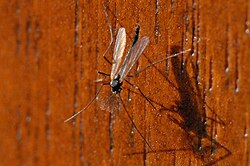| Sergentia | |
|---|---|
 | |
| Sergentia coracina | |
| Scientific classification | |
| Domain: | Eukaryota |
| Kingdom: | Animalia |
| Phylum: | Arthropoda |
| Class: | Insecta |
| Order: | Diptera |
| Family: | Chironomidae |
| Tribe: | Chironomini |
| Genus: | Sergentia Kieffer, 1922 |
This article needs additional citations for verification .(February 2022) |
Sergentia is a genus of European non-biting midges in the subfamily Chironominae of the bloodworm family Chironomidae. [1]